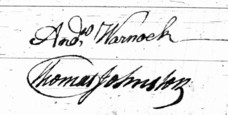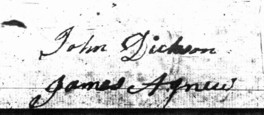William Orr
William Orr
The Irish Merchant of Pendleton District
Compiled and copyrighted December
2010 by Linda Sparks Starr
A history of Ireland, specifically in the years
dealing with events leading up to and including the 1790s, may explain
more thoroughly why William chose to begin a new life in the former
colonies. If he is, as we suspect, the William Orr on the 1800
Pendleton District census, he was in his middle twenties to early
forties when he left his native country. Other records suggest he
was closer to his upper thirties, if not already in his forties, when
he arrived in the Pendleton District. Perhaps William possessed
the wanderlust spirit that led so many of his compatriots to the shores
of the newly created United States. Or perhaps his employers sent
him to run a store in the Carolinas. The exact year of his
arrival in the states is not known. There are indications he lived
elsewhere before moving to the district; but mention that one note
due his estate came from a Charleston account and this statement
by his nephew Thomas in an 1826 petition
is all we have: “your
petitioner further Sheweth that one William Orr an Uncle to Petitioner
being a duly naturalized Citizen of the United States
...” Questions then turn to his trading store. Did
he take
over an existing establishment or did he open a new store to
accommodate the growing population in the area along Twenty Three Mile
Creek? The exact location of his store may have been in the area that
fell into Pickens County in 1826. The 1800 census for Pendleton
District shows household #817 William Orr was in Col. Brown’s
Regiment. According to the editor, this later area fell into Pickens
County. [NGS] Presumably the single William, who was between the
age of 26 and 46, lived near the location of his store, if not in the
back room of that store.
Once William made his way to these parts of the Up-Country, it
didn’t take him long to become a part of the community. Early in
1800 he witnessed a deed with his future business partner, William
Rankin. [Willie p. 240-1 citing Book F p. 122-3]
Grantee
William Orr was identified as merchant in the February 1802 deed when
grantors David and Rebecca Smith
sold him one-half interest in what was
later known as Rankin Mills. The deed
specified just what his $210 purchased: “all the one half
both Grist Mill and saw mill as they both now Stand and are Occupied by
the said David Smith and William Rankin on the 23 Mile Creek with all
the rights and priviledges to build improve and Occupy the same
in equal copartnership ...” A month later William paid
William McMahan $200 for 150 acres on the North side of 23 Mile
Creek. Both these tracts now
lie in Anderson County.
The merchant William Orr died less than eighteen months later. He was
buried far from his native land and equally far from his siblings who
were regarded by the courts as his only legal heirs. Later
records indicate he left a natural
son, named James, who presumably was
born in South Carolina. The lack of a marriage between his parents made
all the difference in James’s childhood. The little that is known
about this James comes from William’s estate papers and later
legal dealings between the two cousins: James son of William and
Thomas, nephew of William. Problems for researchers begin with
the surname name of the
probable mother: “Mary
___ght” is smeared in the surety bond Thomas Orr gave to
the court-appointed administrators of William’s
estate. Mary’s
claims against the estate were particularly mentioned in the list of
promises Thomas made to protect the original administrators
against. Estate Accounts records show payment to Sarah Paulston
(another surname difficult to read) for maintenance of Mr Orr’s
child. Problems with
James haunted William’s nephew,Thomas Orr, at least through 1827.
The petition Thomas
submitted to the South Carolina House of
Representatives is a good place to begin the discussion of William
Orr’s estate.
Stated within the petition: “your
petitioner ... nephew of
William Orr a Naturalized Citizen of the United States of America, late
of Pendleton District in this State deceased. That the said William Orr
about June 1803 departed this life without leaving any Lawful Wife or
children and without making any last Will &
Testatment.” The Pendleton District Court
appointed
three men administrators of William Orr’s estate in September
1803. They, with James Agnew, signed the two-thousand dollars surety
bond.
Payment of the bond was required only if they failed to locate and make
an inventory of all his property, pay his just debts, collect money due
him and otherwise manage the closing out of his estate. Three men were
appointed, but it appears Thomas Johnston, the accountant for the
group, did the most work. An inventory of
the estate was made 6 September 1803 by local
residents
Signatures of appraisers
The total value of William Orr’s estate was set at
$469.75. An estate
sale held just days later brought in
$588.87 1/3. Wm Orr Estate Sale Both horses brought far
more than their appraised value; but, farm rent and five cows,
forgotten at the time of the inventory, were added which makes up some
of the difference between the two. The sale drew a crowd; the
Revolutionary War hero Andrew Pickens Sr. purchased one of the horses.
The Estate Accounting Records,
submitted to the courts yearly and
audited by a court official, are considered boring to most people. In
this case they provide a list of area residents possibly not found
elsewhere.
Thomas Orr arrived on the Pendleton
scene early in
1805. The power of
attorney he carried from
William’s relatives living in Ireland is a great aide for
researchers hoping to trace this ORR line backwards in time. It
provides the names, residence and occupation in April 1804 of
William’s siblings: Samuel Orr of Carlagan, County
Monaghan, farmer; Robert Orr of Muhuaidghuby, carpenter; Alexander Orr
of Bellaheagh, County Armagh, weaver; and Alexander Whiteraft of
Glassnknow, County Monaghan, farmer and Ann Whiteraft otherwise Orr his
wife. Additionally the POA identifies William as formerly of
Gleneheim, County Monaghan. Information within this
POA and
mention of his child (not named) in his estate papers is the only hints
we have for further research.
His son, James, is almost as much of a mystery as
William. It appears to be a known fact within the community that
William was his father. Yet, William didn’t legally acknowledge
him as his son. Not wanting to marry the mother is one thing, but not
providing for a child is another. His acknowledgement would have
meant the courts would see that James was provided with some, if not
all, of William’s estate. As it is, all legal records
suggest William’s siblings in Ireland got everything.
However, Thomas, by himself or likely at the behest of unnamed
relatives in Ireland, made some provision for James. Within his
petition to the state House of Representatives in 1827, Thomas wrote:
“Your petitioner has greatly
assisted the said James in obtaining
an education and getting him into Business & is informed the said
James is doing good business as a merchant.” James,
understandably and perhaps with reason, wanted more. Although his
petition has yet to be viewed, the counter-petition submitted by
Thomas contains this statement: “...
one James Orr __ Natural (or
illegitimate) son of the said William Orr has petitioned the
Legislature to vest in him the legal title to the said tract of 150
acres of land or to have the same Escheated the proceeds given to
him.” The 150 acre tract they are arguing about is
the lot William Orr purchased from William McMahan in
1802. Although the actual events aren’t documented,
Thomas indicates he
purchased the tract with his own money from his relatives in Ireland.
Nothing more is specifically known about James, son
of William Orr. Researchers differ over which James died 12
September 1873 leaving a widow Georgiana Orr. After her
husband’s death she filed a petition for Homestead against John
B. Orr and (who I think were) children of her deceased husband and his
first wife. Some say her husband is this James (born before June
1803) while others think her husband was James, son of Thomas and
Sarah, born 1821. Sarah, wife of that James, died May 1872.
SOURCES
____, compilers. 1800 Census Pendleton District, South
Carolina. National Genealogical Society 1963.
Willie, Betty, compiler & abstractor. Pendleton District,
South Carolina Deeds 1790-1806 Southern Historical Press, 2001
Greenville, SC.
Linda Sparks Starr copyright (c) December 2010
lsstarr@pilgrimage.us
Home: http://homepages.rootsweb.ancestry.com/~lksstarr/




